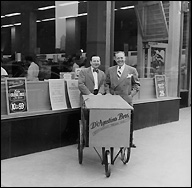![]()
Departments
![]()

|
Week of 23 April 1999 |
Vol. II, No. 32 |
Feature Article
BU conference reveals breadth of American studies
By Hope Green
In 1932, two Italian brothers in New York City traded in their pushcart for a small grocery store, a venture that eventually blossomed into an upscale chain known as D'Agostino Supermarkets. In the late 1990s, BU doctoral candidate Paul Schmitz (GRS'03) has found in their success story a tale of clever advertising and fodder for a wide-ranging research paper.
Schmitz was one of two BU presenters at a recent graduate student conference, There's No Place Like Home: Public and Private Life in America's Places, co-sponsored by the Society for the Preservation of New England Antiquities (SPNEA) and the GRS American and New England Studies Program (AMNESP). In April 9 and 10 presentations on campus and at SPNEA's downtown headquarters, 10 scholars from eight universities and liberal arts colleges explored topics ranging from 19th-century domestic violence to the societal implications of air-conditioning.
|
|
|
Nicholas and Pasquale "Patsy" D'Agostino, founders of D'Agostino Supermarkets in New York, were the focus of a paper presented at a recent SPNEA-BU graduate student conference. |
|
|
From its inception 28 years ago, Schulman says, AMNESP has cultivated close relationships with Boston-area museums and organizations such as SPNEA. The program takes an interdisciplinary approach to the study of American society, incorporating such fields as art, literature, history, religion, architecture, and consumerism.
Many of these areas overlapped at the conference. AMNESP doctoral candidate Stephen Hodin's presentation, for example, compared Nathaniel Hawthorne's 1832 short story "My Kinsman, Major Molineux" with a blockbuster museum attraction from the same era called The Infernal Regions, a ghoulish chamber of horrors designed by sculptor Hiram Powers. Hodin (GRS'02) explained how in a darkened room of Cincinnati's Western Museum, mechanized wax figures appeared to be punishing sinners for their misdeeds. He argued that the netherworld fantasy played to a timely public fascination with sin, vice, and temptation during the 19th-century industrial revolution. He spoke of how Americans simultaneously feared and relished their emerging urban lifestyle as they left their simpler, more virtuous existence in the hinterlands behind. The Hawthorne story and the exhibit, he argued, have a common central theme: "the sudden exposure of the innocent rustic to the disorienting and licentious arena of the city."
Sharing the session with Hodin was Julia Toews, a doctoral candidate from Johns Hopkins University who spoke on Charles Brockden Brown's novel Arthur Mervyn. Toews used the novel as a framework for analyzing the effect of city life on the American family.
A New York-themed session included Schmitz's discussion of D'Agostino's and a talk by New York University scholar David Kinkela, who looked at the social consequences of air-conditioning in the city from 1920 to 1980. Schmitz described how the D'Agostino family capitalized on their rags-to-riches history and their proud immigrant heritage in their advertising, evoking for their well-heeled customers -- themselves children of immigrants -- a connection to the American dream. Simultaneously the D'Agostinos cultivated an image for their stores as "markets of distinction," where knowledgeable staff selected only prime cuts of meat and choice fruit and vegetables.
Kinkela's presentation looked at the way air-conditioning in office buildings and private homes "changed the manner in which New Yorkers negotiated urban spaces" and argued that this in turn "redefined connections between the city and its people." Whereas the earliest air conditioners were used to cool public buildings such as movie theaters and department stores, the 1950s saw the advent of the window unit for private homes, at the time a status symbol for the middle class. Kinkela argued that the resulting closed windows and interior white noise "separated citizens from the outside world and community," while the city's poorer residents attempted to keep cool by staying outdoors. He also noted how air-conditioning influenced the newly austere architecture of office buildings during Manhattan's post-World War II construction boom.
In his formal response to Kinkela and Schmitz, Schulman remarked that both papers pointed to city dwellers' "profound insecurity" about class identity, modernity, and consumerism. Both scholars, he said, illustrated how upwardly mobile young people were trying to distinguish themselves with the "best" consumer purchases, paradoxically taken with the icon of the noble, earthy immigrant produce merchant while -- inside their genteel, climate-controlled homes -- insulating themselves from the grittiness of the street.
Besides Schulman, respondents included CAS Assistant Professor of English Laura Korobkin and faculty from Northeastern University and Simmons College. Last year the conference was a one-day affair, but the recent event added the Friday evening session. Students from across the United States, as well as from Canada, Mexico, and even Italy, submitted papers for the conference committee's review.
The keynote speaker was Richard Bushman, the Governeur Morris Professor of History at Columbia University, who in his lecture used stories from Mormon life as a basis for exploring American perceptions of the home. Author of The Refinement of America, Bushman is known for his work on the revolution in American tastes and manners that coincided with the Revolutionary War era. He taught at BU for several years and was involved in the creation of AMNESP in 1971 along with John Armstrong and David Hall, also BU professors at that time.
"In those days we had to scramble for every penny we got in order to fund a few graduate fellowships," Bushman recalls. "David Hall was perpetually going to Washington in search of government funds. I am very proud that AMNESP has emerged at the top of the graduate programs in American material culture in this country."

